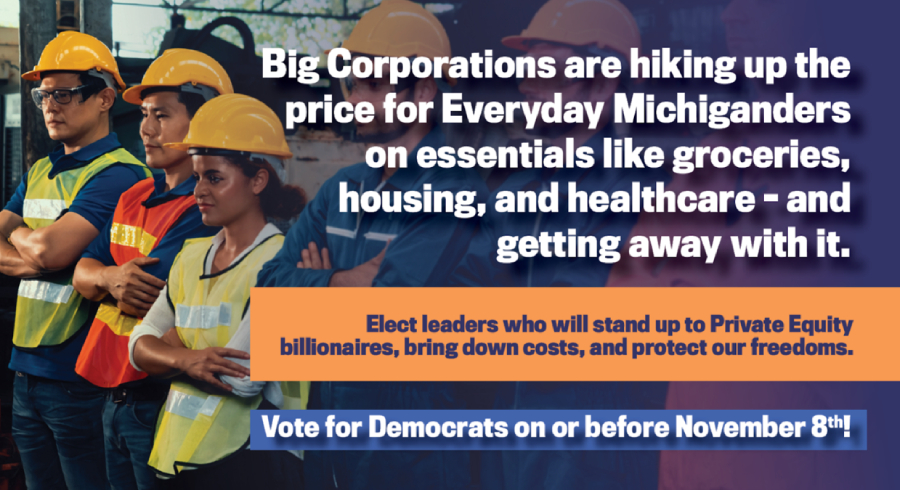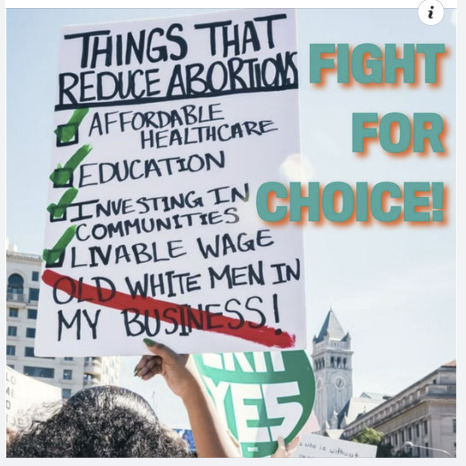Surge voters made the difference in 2022.
Their top concern? The economy and inflation.
Here’s how Vote for Respect’s anti-corporate messaging strategy (that referenced abortion rights) mobilized the mid-term surge turnout.
Where we focused:
We honed in on four of the most competitive states, where we have active leaders: Georgia, Texas, Michigan, and North Carolina.
Who we worked with:
UFR and Americans for Financial Reform teamed up with Skyridge Strategies to develop a narrative strategy to link concerns about high inflation among this segment of voters with private equity price gouging and corporate greed, and Data for Progress to assess messaging tests.
What we found:
We tested our messaging approach with a poll of surge voters in Georgia, which confirmed that inflation was the top concern for these folks (by a lot), and that the best-performing messaging linked high prices to corporate greed and this election’s broader theme of protecting our freedoms.
We put these findings to work.
Get the details on what we found:
“Surge voters” typically trend under 45, are BIPOC, and working class – and too often, are overlooked by the progressive movement (even though investing in reaching them usually has a bigger payoff at the polls).
We saw a critical gap that we could fill with our progressive partners, and jumped in to target people who voted in at least one of the last three national elections (2016, 2018, and 2020) or were newly registered.
But we hit challenges with data gaps: Since these voters are usually lower-income, they’re usually renters who move more often. That makes it harder to ensure the data available for them is accurate and provides a full picture, so we invested heavily in texting and paid digital programs to make up for what we might miss with physical addresses.
The GOTV postcard test that had proven results:
In Michigan, United for Respect tested a variety of messages delivered via postcard to determine what would generate a measurable increase in turnout. Our hypothesis? That a first-person narrative directly from a retail worker, delivered to low-wage workers, would resonate more than a third-party framing and bring more people to the polls, and we were right.
The Control:
One group of surge voters received a postcard using a generic version of our anti-corporate messaging, tying inflation to private equity’s greed.

The Test
The second test group of surge voters received a postcard that told a familiar, personal, and first-person story about how private equity’s greed has harmed working people.

The test measurably out performed both the control group and a third segment that didn’t receive any postcard at all, with the findings being statistically significant. When applied across many large states, this could have a major impact at no additional cost, turning out 1 new voter for each 1,000 postcards.
With abortion being a top issue
– and with people capable of pregnancy overrepresented in our target audience –
our digital program coupled this message with economic justice.
Ads that connected the two outperformed ads that had standalone pro-choice imagery or standalone anti-corporate greed messaging, with our top ad image heavily linking the two messages together:

In our target states, these ads (which directed users to voting information and resources) resonated best with Gen Z and Millennial women. Our national ads (which instead pointed supporters to sign-up to volunteer for GOTV efforts) resonated most with women over 65.
Our best-performing ads combined this imagery with candidate-specific anti-corporate greed messaging (e.g. “Candidate X will fight for us, not corporate billionaires”).
Our focus on bringing younger and less reliable voters to the ballot box in an off-year likely contributed to the youth “surge vote” that built a winning coalition.
Post-election exit polls matched what we found in our message testing in Georgia, continuing to show inflation and economic concerns as top-of-mind.
An internal progressive movement exit poll in Georgia asked voters about “the single biggest issue to you personally and the reason and motivation for your vote?” Voters selected “Jobs and the Economy” and Inflation at higher rates than even Abortion. (Want details on the poll? Contact us for more info.)
AFR’s and UFR’s approach to situate the inflation concern of surge voters in a progressive, anti-corporate agenda connected high prices for everyday essentials like rent and groceries to broader themes of corporate greed, Private Equity, market monopolization, and Wall Street deregulation/financialization. As E. Tammy Kim noted in The New Yorker in the weeks prior to election day:
“The progressive advocacy group United for Respect has recommended that Democrats reframe inflation as “price gouging” by Wall Street and private-equity firms. Candidates in tossup Senate races—in Pennsylvania, Ohio, Georgia, and Wisconsin—have taken the hint, connecting rising prices to “corporate greed,” “corporate interests,” and “record profits.” John Fetterman, Pennsylvania’s lieutenant governor, has tried to swaddle this message in a Pittsburghian working-class hoodie aesthetic. Raphael Warnock, the incumbent Georgia senator, and Tim Ryan, the Ohio congressman, have bragged of their votes for two of Biden’s signature economic bills: the Inflation Reduction Act (which will reduce prescription-drug costs for Medicare recipients, create infrastructure jobs, encourage green energy, and raise taxes on large corporations) and the Chips and Science Act (which aims to address microchip shortages and spur U.S. manufacturing).”
Surge Voters are the path to victory. Progressive candidates should prioritize the agenda that matters most to these voters:
Stopping Wall Street looting and fighting for the working class.
2022 shows us that surge voters, particularly younger voters, understand connections between abortion rights and cost of living crisis worsened by inflation. As our results show, these interests aren’t pitted against each other but rather fit together as part of bold progressive agenda. Democratic campaigns shouldn’t away from economic issues or naming the enemy. Senator-elect Fetterman’s use of “Greed-flation” is perhaps the best example of how this tack helped secure our only Senate pick up. This result provides a strategic direction for Democrats, and should guide governance priorities that demonstrate why electing Democrats makes working class Americans’ lives better – such as protections from Private Equity abuses in the Stop Wall Street Looting Act, the FAMILY Act’s paid leave provisions, and increasing the federal minimum wage to at least $15.
The bottom line is that while Republicans hit the ceiling with older white voters, surge voters break for Democrats by large margins. Targeting them using mobile and digital tactics, as well as traditional field programs, is a strategy we must expand in 2024. To do this, we need more resources and consistent support year-round to continue this work. Our innovative approach shows promising results and we look forward to partnering with others to bring this to an even broader scale in future cycles.